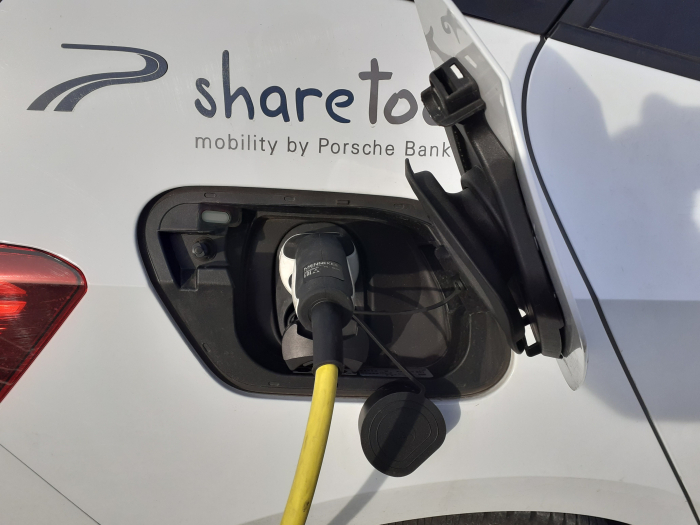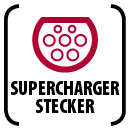CHARGING CABLES AND PLUGS FOR ELECTRIC CARS AND PHEV MODELS
MAXIMUM RANGE IS THE GOAL!
Due to various queries, we will also try to give a simple and comprehensive answer here. On the subject of charging cable types and plug types in e-cars and plug-in hybrid vehicles (PHEV Plug-in Hybrid Electric Vehicle, or "plug-in hybrid").
For more detailed questions, please contact the car dealer or parts dealer you trust.

Which charging cables are available for charging the high-voltage battery in the electric car?
Mode 2 charging cable
Most electric cars are equipped with a mode 2 charging cable ex works. This cable is suitable for connection to a conventional household socket (Schuko plug). It is often supplied by the manufacturer. To ensure that the electric car is charged, a so-called in-cable control box (ICCB) acts as a communicator between the electric vehicle and the charging connection.
Mode 3 charging cable
Recharging is much faster and more convenient with the Mode 3 charging cable via a charging station or so-called wallbox. Here, the cable is almost always permanently integrated and enables charging power of up to 43 kW! The Type 2 plug is practically the industry standard in Europe and charging stations are often equipped with it. This means that electric vehicles can be charged from both Type 1 (Asian and US cars) and Type 2 (European cars). So that electric cars can charge with both type 1 and type 2 plugs, charging stations are often equipped with a type 2 socket. To charge your electric car, you will need either a Mode 3 charging cable from Type 2 to Type 2 or a Mode 3 charging cable from Type 2 to Type 1, depending on the make of car.

Which plug fits which electric car?
Type 1 plug
The single-phase type 1 plug with a charging capacity of up to 7.4 kW (230 V, 32 A) is used as standard primarily in car models from the Asian or
American region and is rather uncommon in Europe. This plug, which has five contacts, communicates via two power conductors and is suitable for single-phase charging with a voltage of 110 or 230 volts. In Europe, however, there are hardly any charging stations with a permanently attached type 1 charging cable.

Type 2 plug
The three-phase Type 2 plug with a charging capacity of up to 22 kW (400 V, 32 A) in the private sector and up to 43 kW (400 V, 63 A) at public charging stations is the most widely used in Europe and is considered the EU standard. It is also known as the Mennekes plug. A mode 3 cable can be connected to most public charging
Most public charging stations can be connected to a Mode 3 cable, which allows both e-mobiles with Type 1 and Type 2 plugs to be charged. If the station is connected via the three-phase network, charging is much faster and more effective. In addition, type 2 is secured against unauthorised disconnection.

Combo plug (CCS Combined Charging System)
The Combo plug (CCS) has two complementary power contacts and thus expands the Type 2 plug to include a fast-charging function. This plug supports AC and DC charging (alternating current and direct current charging) theoretically with up to 170 kW. In everyday use, the maximum is approx. 50 kW.
The CCS charging system is favoured by European, US American and South Korean e-car manufacturers.

CHAdeMO plug
(CHArge de MOve - charging to move is part of the Japanese phrase "Ocha demo ikaga desuka" - translates to "How about a cup of tea?" as a reference to time use during charging).
This fast charging system, which was developed in Japan, is comparable to the CSS system. It also allows charging powers of up to 100 kW, but is rather rare in Europe. Please note: At many public charging stations, the charging power is limited to 50 kW. However, many electric cars are compatible with the CHAdeMo plug, and some even have a plug adapter.
The CHAdeMO charging system is being pushed by Japanese e-car manufacturers and is the main competitor to the CCS system (Combined Charging System).

CHAoJI plug
The first vehicles equipped with this plug have been on sale since 2023. The plug was developed together with the Chinese GB/T charging standard. They are combined AC/DC vehicle sockets, both for the IEC type 1 (SAE J1772) and for the IEC type 2 plug, similar to the CCS system. Cable adapters are available for all common DC charging systems (CHAdeMO 2.0, GB/T 2015, CCS and Tesla Type 2).
In contrast to the combo plug (CCS Combined Charging System), the CHAoJi plug has all the contacts required for the charging process in the DC area; the cable plug is therefore much more compact than the CCS cable coupling. The combined ChAoJI/Type2 vehicle connector is only slightly larger than a CCS vehicle connector. The locking mechanism of the connector system is implemented on the vehicle side.
The CHAoJI connector is a further development of the CHAdeMO connector system, developed by Japanese and Chinese vehicle manufacturers (CHAdeMO 3.0 specification). CHAdeMO 4.0/Ultra CHAoJI will then also allow charging in the megawatt range with additional DC conductors!

Which plug for at home, in the car dealership/workshop and on the road?
Schuko socket
Conventional household sockets (Schuko sockets) are sometimes installed at public charging stations. They allow all electric vehicles to be charged via a Mode 2 charging cable. To achieve a charging power of up to 3.7 kW (230 V, 16 A), additional fusing is recommended. Without checking the socket beforehand, a maximum charging power of 2.3 kW (230 V, 10 A) is recommended. This charging option exists for all electric cars.

CEE plug
Here, there is the single-phase blue version, which is often found in the camping sector with a charging capacity of up to 3.7 kW (230 V, 16 A). The three-phase red version for industrial sockets is offered in two versions: Firstly, the small industrial plug (CEEl 6) with charging capacities of up to 11 kW (400 V, 16 A), and secondly, the large industrial plug (CEE32) enables charging capacities of up to 22 kW (400 V, 32 A).

Tesla Supercharger
The Tesla Supercharger is a modification of the Mennekes Type 2 plug. It allows 80% charging of the Tesla electric car in only 30 minutes with a charging power of up to 120 kW (direct current). Tesla Superchargers are not yet available for other car brands or models.
Good to know: Depending on the electric car manufacturer, the 12V starter and on-board power supply battery is always charged during the charging process of the high-voltage battery - i.e. regardless of the state of charge (SOC State Of Charge) - or only when the high-voltage battery is charged to approx. 80%. A look at the operating instructions of the respective electric car or PHEV vehicle can be really helpful.
A quick word: The lithium-ion drive battery is also known as a high-voltage battery (HV = Hochvolt).
PS: All the products listed are not in the Banner sales range.
More articles on this topic

